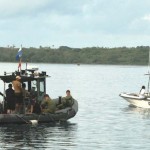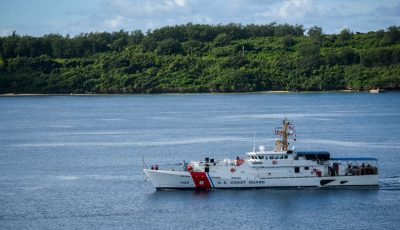Work continues to restore coral in Apra Harbor
- From left, Guam Environmental Protection Agency Environmental Monitor Analytical Services administrator Jesse Cruz, National Oceanic and Atmospheric Administration biologist Valerie Brown, and Navy Explosive Ordnance Disposal Mobile Unit Five chief explosive ordnance disposal technician J.P. Delassus take part in an early morning briefing on the Jade Shoals coral restoration project at the Apra Harbor seaplane ramp in Piti on June 29. (NAVFAC MARIANAS PUBLIC AFFAIRS OFFICE)
- Divers and biologists aboard boats from Navy Explosive Ordnance Disposal Mobile Unit 5 and the Guam Department of Agriculture Division of Aquatic and Wildlife Resources depart from the Apra Harbor seaplane ramp to take part in the Jade Shoals coral restoration project in Piti on June 29. (NAVFAC MARIANAS PUBLIC AFFAIRS OFFICE)
PITI, Guam—Navy divers and marine biologist divers have been working since June 28 to restore coral accidentally impacted during a military exercise at Jade Shoals in Apra Harbor.
“We always strive to be good stewards of the environment no matter where we are,” said Naval Base Guam commanding officer Capt. Hans Sholley. “This is part of our outreach to the community and part of our responsibilities as stewards of the environment to help with projects like this.”
In a well-coordinated One Guam cooperative effort, divers are relocating the coral rubble dislodged by a French navy landing craft to a deep sandy area to prevent it from scouring the nearby live coral with wave action. The dive team are also planning to reattach and stabilize 17 of the larger coral heads at suitable sites using a special cement mixture, rebar, meshing, and cable ties.
While coral reattachment is uncommon in Guam, a 2015 experiment used Navy divers enabled them to relocate 120 coral colonies within Apra Harbor. The experience gained during the relocation efforts bodes well for the Jade Shoals project.
“It has been over two years since those corals were transferred,” said NBG/Naval Facilities Engineering Command Marianas Environmental Program director Ed Moon. “After five monitoring surveys by marine biologists, the vast majority of corals have survived the translocation.”
In the spirit of One Guam, project partners include personnel from NBG, Explosive Ordnance Disposal Mobile Unit Five, the Guam Environmental Protection Agency, National Oceanic and Atmospheric Administration, Bureau of Statistics and Plans Guam Coastal Management Program, Department of Agriculture Division of Aquatic and Wildlife Resources, University of Guam Marine Lab, Guam Customs and Quarantine Agency, and the Port Authority of Guam.
“A clean and safe environment is one of the greatest legacies we can pass along to our future generations,” said Guam Environmental Protection Agency administrator Walter Leon Guerrero. “Given the limited resources that exist on our island, our agency is blessed to have a great support network with our local and federal counterparts. PAG, Guam CQA, DAWR and UOG along with NOAA and Naval Base Guam have answered the call of a coral reef in distress.”
Marine biologists on the One Guam team evaluated the damage and developed a restoration plan for the Jade Shoals coral site that was affected.
“It is unfortunate that this incident occurred in the first place,” said Leon Guerrero, “but we are glad to know that we can count on the sense of environmental stewardship of these concerned agencies, and we cannot thank them enough.”
“We’re happy to provide divers and support for this critically important project to help make this a pristine place and to make Apra Harbor a wonderful habitat,” said Sholley. The team anticipates completion of the Jade Shoals coral restoration project by the end of July. (USN)




























